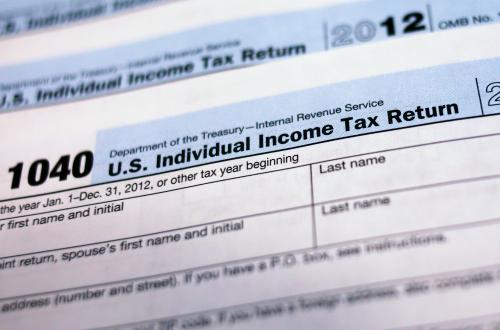The Tax Cuts and Jobs Act of 2017 (TCJA) left many promises of tax reform unfilled. It put deficits and debt on an unsustainable trajectory, created uncertainty for individuals and businesses, and failed to simplify an overly complicated tax system. And though it will provide temporary economic stimulus, its effects on long-term economic growth will be meager—and its boost to Americans’ future living standards even smaller.
Ultimately, the TCJA punts real tax reform down the road. Facing an unstable fiscal situation, future lawmakers will have to act. Stabilizing the debt-to-GDP ratio at today’s level over the next 30 years would require herculean policy changes—some combination of permanent spending cuts or tax increases equal to 4.0 percent of GDP (Auerbach, Gale, and Krupkin 2018). Increases in revenues will be a necessary component of any plan to meet the nation’s fiscal challenges. So where should Congress go from here?
The good news is that our tax system is fixable. In a new paper published by the Urban-Brookings Tax Policy Center, we identify six ways future legislatures can raise revenue, reduce economic distortions, and promote economic growth. You can read a short summary of those strategies below. For more detail, download the full paper.
Ultimately, the TCJA punts real tax reform down the road.
1. Tax old capital and provide incentives for new investment.
If you’re an avid reader of economic literature on taxation (like we are), you know that many economists support reforms that tax “old capital”—that is, capital that is already committed—to finance lower rates on wages and new investment (implementing a consumption tax would be one, but not the only, way of doing this). Such reforms improve the prospects for both workers and active investors because they increase new investment, but without shifting the tax burden to workers. The TCJA does the opposite: it provides windfall gains to old capital, which not only presents a host of political and distributional challenges, but means the bill’s effects on growth are likely to be meager over the long run. As such, reversing the major components of the bill that produce these windfall gains can be an efficient way to raise revenue.
There are good arguments that the reduction in the corporate rate to 21 percent went too far. A corporate rate in the range of between 25 to 28 percent would keep the rate comparable to those in other developed economies and eliminate inefficient tax sheltering and tax avoidance behaviors that will arise when the rate on business income is below that on wages.
A related option is to eliminate the pass-through deduction. The reduced rate on pass-through business income reduces progressivity, picks winners among businesses, increases complexity, and exacerbates domestic distortions, all while cutting revenues.
Finally, lawmakers looking for ways to expand pro-growth elements can look to expand and make permanent TCJA’s provisions that allow companies to expense new investments and which simplify accounting rules for small businesses.
2. Fix the international tax system and limit provisions that facilitate corporate avoidance and income shifting.
The TCJA’s general approach to international taxation is conceptually sound, particularly if the U.S. is to remain locked into the basic corporate tax structure and tax base that has prevailed in the past. However, the plan does too little to reduce profit shifting, encourages a race to the bottom in international tax rates and norms, and retains incentives for U.S. companies to locate activities abroad. Several changes in the international tax regime could protect the U.S. tax base, reduce profit shifting, and raise revenue.
First, the special low rate on export income associated with intangibles (i.e., Foreign Derived Intangible Income) is unlikely to comply with World Trade Organization rules and may be designated an export subsidy. Moreover, there is little justification for the provision: it will be complicated, costly, and difficult to enforce— and there is little evidence similar approaches encourage innovation or influence locational choices. Other approaches, like the Research & Experimentation credit, are more efficacious ways to promote domestic innovation.
Second, the international minimum tax rate is too low, its base-narrowing allowance for foreign income from tangible investments is too generous, and the rules for applying foreign tax credits need repair. With a low rate and a narrow tax base, the incentive to locate certain activities in foreign jurisdictions rather than the U.S. is strengthened. Increasing the minimum tax rate to, say, 15 percent—net of 80 percent of foreign taxes paid—and reducing the tangible equity allowance from 10 percent to the rate applied to risk-free investments would reduce the ability and incentive to shift profits abroad to very low-tax jurisdictions. Rather than calculating the minimum tax based on the average tax paid across all foreign income, which allows companies operating in high-tax jurisdictions to benefit by booking more profits in tax havens to offset taxes paid elsewhere, the minimum tax could be applied on a country-by-country basis.
Third, while the corporate reform includes stronger rules to limit interest expense, key provisions that prevented multinational (or foreign-owned) corporations from loading up their U.S. subsidiaries with disproportionate amounts of interest expense were dropped at the last minute. As a result, foreign-owned firms—including inverted companies—retain a tax advantage over domestic firms. Along with stronger monitoring of transfer pricing, stronger limitations on interest expense would reduce erosion of the U.S. base.
3. Change the taxation of capital to promote more uniform taxation.
The TCJA exacerbated certain shareholder-level tax expenditures because of changes in corporate or pass-through taxes. For instance, lower rates on corporate and pass-through businesses and expensing provisions increase the costs of tax expenditures ranging from the exclusion of capital gains at death to tax-exempt savings vehicles. And tax rates on investments continue to face different effective and marginal tax rates depending on the type of account in which the investment is held, when the asset is sold, and how the investment is financed. These distortions reduce economic activity by shunting investments away from their most efficient uses.
Eliminating stepped-up basis (which allows someone inheriting capital investments to avoid paying capital gains taxes on gains accrued before the original owner’s death) and instead taxing capital gains at death or requiring carryover basis would be an equitable and efficient way to reduce the revenue loss from business-level tax cuts by shifting some of the tax burden to shareholders.
Another option for shifting the burden to shareholders from corporations would be to curtail a wide range of tax expenditures that allow corporate income to avoid tax. For instance, one approach is to strengthen anti-abuse rules for closely held stock in Roth IRAs, which allow IRA owners to shelter labor income by allowing an effective tax rate of zero on income from these assets.
Lastly, reform could subject tax-exempt organizations to tax on a larger share of their business profits. Tax-exempt organizations pay no tax on activities related to their exempt purpose. With a few exceptions, they also avoid tax on their investment income, including capital gains and dividends from corporations.
4. Reduce distortionary tax preferences in the individual tax code.
Any reform designed to maximize sustainable growth should address provisions of the tax code that incentive taxpayers to take actions that don’t have positive social benefits. Take, for example, the unlimited exclusion for employer-provided health insurance, which encourages a greater share of compensation to be delivered in the form of health insurance, rather than wages. This provision encourages overconsumption of health services, pushes up the cost of health insurance, and is estimated by the Joint Committee on Taxation to cost $155 billion in 2017 alone.
The Cadillac Tax, which imposes a surcharge on extremely expensive plans whose generosity exceeds a high threshold, is a judicious, effective, and incremental approach to addressing this distortion—it should be allowed to go into effect.
A wide variety of other tax expenditures are also good candidates for reform, ranging from changes in the mortgage interest deduction to incentivize homeownership, in retirement saving provisions to make them more effective and equitable, and in a wide array of smaller credits, deductions, and exclusions which could be consolidated, simplified, and more narrowly targeted.
5. Encourage working-age Americans to enter the labor force and supply more labor.
In designing a tax system, policymakers should be careful that programs and rules don’t impose artificial or inefficient barriers to employment. By reducing the marginal tax rate for many taxpayers in the near-term, the TCJA created incentives for existing workers to supply more labor (at least through 2025). But the approach was poorly designed to raise labor force participation or employment, and explicitly temporary, limiting its effectiveness.
Efficient options to encourage labor force participation include expanding the EITC to childless workers and to currently ineligible younger and older workers; providing tax relief for secondary earners to increase labor supply of married taxpayers; and legislating more generous benefits for child care to reduce the implicit tax on work for parents.
6. Improve compliance
Finally, taxpayers need help complying with the tax code and tax laws need to be enforced. Tax compliance is often measured in terms of the “tax gap,” which is the difference between taxes owed and taxes paid. Because of its size—it’s estimated to cost the U.S. government between $450 and $650 billion a year—even small, sustained reductions in the tax gap can contribute to deficit reduction.
Unfortunately, when it comes to tax compliance, there are no short cuts. Improvement requires a simpler tax system and more resources for the IRS to aid taxpayers and enforce the law.
The authors did not receive any financial support from any firm or person for this article or from any firm or person with a financial or political interest in this article. They are currently not an officer, director, or board member of any organization with an interest in this article






Commentary
6 ways to fix the tax system post-TCJA
May 25, 2018